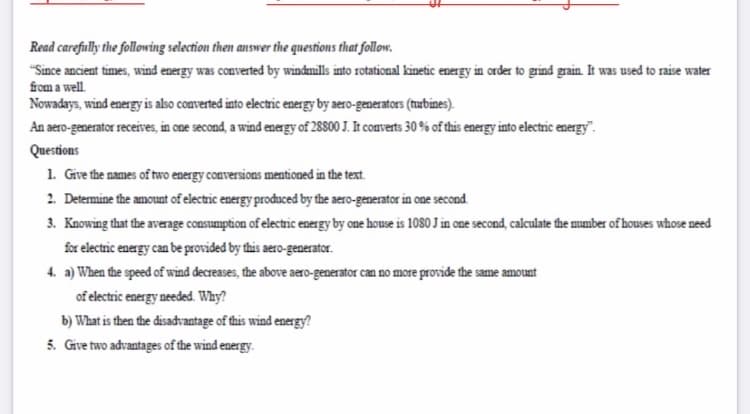Read carefully the following selection then answer the questions that follow. "Sunce ancient times, wind energy was converted by windmls into rotational kzinetic energy in order to grind grain. It was used to raise water from a well. Nowadays, wind energy is also converted into electric energy by aero-generators (nubines). An aero-generator receives, in cne second, a wind energy of 28800 J. It converts 30 % of this energy into electric energy". Questions 1. Give the names of two energy conversions mentioned in the text. 2. Determine the amount of electric energy produced by the aero-generator in cne second. 3. Knowing that the avernge consumption of electric energy by one house is 108O J in one second, calculate the muanber of houses whose need for electric energy can be provided by this aero-generator. 4. a) When the speed of wind decreases, the above aero-generator can no more provide the same amount of electric energy needed. Why? b) What is then the disadvantage of this wind energy? 5. Give two advantages of the wind energy.
Read carefully the following selection then answer the questions that follow. "Sunce ancient times, wind energy was converted by windmls into rotational kzinetic energy in order to grind grain. It was used to raise water from a well. Nowadays, wind energy is also converted into electric energy by aero-generators (nubines). An aero-generator receives, in cne second, a wind energy of 28800 J. It converts 30 % of this energy into electric energy". Questions 1. Give the names of two energy conversions mentioned in the text. 2. Determine the amount of electric energy produced by the aero-generator in cne second. 3. Knowing that the avernge consumption of electric energy by one house is 108O J in one second, calculate the muanber of houses whose need for electric energy can be provided by this aero-generator. 4. a) When the speed of wind decreases, the above aero-generator can no more provide the same amount of electric energy needed. Why? b) What is then the disadvantage of this wind energy? 5. Give two advantages of the wind energy.
Glencoe Physics: Principles and Problems, Student Edition
1st Edition
ISBN:9780078807213
Author:Paul W. Zitzewitz
Publisher:Paul W. Zitzewitz
Chapter10: Work, Energy And Machines
Section10.2: Machines
Problem 28PP
Related questions
Question
100%
Help please

Transcribed Image Text:Read carefully the following selection then answer tihe questions that follow.
"Since ancient times, wind energy was converted by windmills into rotational kinetic energy in order to grind grain. It was used to raise water
from a well.
Nowadays, wind energy is also converted into electric energy by aero-generators (nubines).
An aero-generator receives, in one second, a wind energy of 28800 J. It comverts 30 % of this energy into electric energy".
Questions
1. Give the names of two energy conversions mentioned in the text.
2. Determine the amount of electric energy produced by the aero-generator in one second.
3. Knowing that the average consumption of electric energy by one house is 1080 J in one second, calculate the mumber of houses whose need
for electric energy can be provided by this aero-generator.
4. a) When the speed of wind decreases, the above aero-generator can no more provide the same amount
of electric energy needed. Why?
b) What is then the disadvantage of this wind energy?
5. Give two advantages of the wind energy.
Expert Solution
This question has been solved!
Explore an expertly crafted, step-by-step solution for a thorough understanding of key concepts.
This is a popular solution!
Trending now
This is a popular solution!
Step by step
Solved in 3 steps

Knowledge Booster
Learn more about
Need a deep-dive on the concept behind this application? Look no further. Learn more about this topic, physics and related others by exploring similar questions and additional content below.Recommended textbooks for you

Glencoe Physics: Principles and Problems, Student…
Physics
ISBN:
9780078807213
Author:
Paul W. Zitzewitz
Publisher:
Glencoe/McGraw-Hill

Glencoe Physics: Principles and Problems, Student…
Physics
ISBN:
9780078807213
Author:
Paul W. Zitzewitz
Publisher:
Glencoe/McGraw-Hill